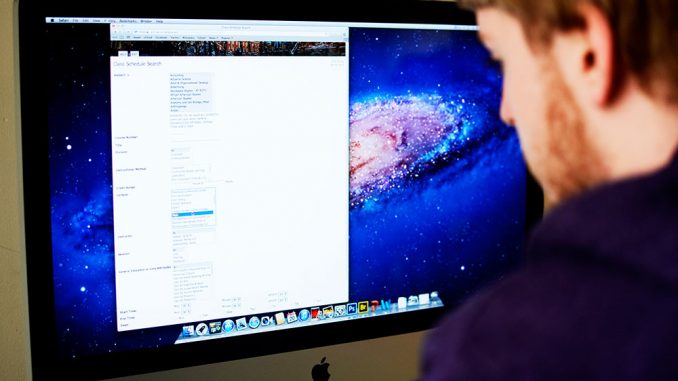
Accounting Professor Christian Wurst sits quietly in his home office while his dog, curled up and asleep, lies by his feet. On the computer screen in front of him, he toggles between selections of some 40 students’ live webcam feeds during one of his online classes.
This, Wurst said, is face-to-face interaction, despite the fact that the faces are pixelated on the computer screen.
“The only difference is that we aren’t breathing the same air,” he said.
Some argue that personal interaction, a crucial part of education, cannot occur between computer screens. This is one of the reasons why it is sometimes suggested that online courses will never be as successful as traditional classes.
Despite these perceived limits, Wurst disagreed. He noted a number of benefits provided by online courses.
“In a classroom, I don’t get to know more than 10 to 15 percent of classes of 300 students,” he said. “Online classes tend to be smaller and more intimate insofar as that I get the feeling that I’m looking and talking directly to you one at a time.”
But sophomore Alex Suleski, who recently took an accounting class online, said some students may feel discouraged from participating online for various reasons.
“It’s a chat room, and whenever you ask a question, your face pops up on the screen for everyone to see,” Suleski said. “That made people not want to ask questions because it put them on the spot.”
Not all online courses operate with chat room-style interaction, but it is typical among online classes at Temple. Wurst said he believes technology is a useful tool in that it can adjust to the needs of different students, especially if they don’t like a particular style of teaching.
“Good technology has to be transparent,” Wurst said. “Just like a fish doesn’t know he’s in water, when you’re teaching online you have to not know you’re online.”
Wurst credits some of his success with technology to Darin Kapanjie, who is in charge of Temple’s Online and Digital Learning Team. The team helps professors manipulate the technology necessary for online courses.
“They had a tech guy sitting next to me for the first five weeks,” Wurst said. “They were unbelievably helpful.”
Kapanjie said he sees technology as an essential stream between the professor and the student.
“I wouldn’t teach online if I couldn’t get my online students the same experiences as regular students,” Kapanjie said.
Professors like Kapanjie and Wurst not only attempt to give online and traditional students similar experiences, but also similar workloads.
“[Online classes] can be harder because you have to master the same content with the same standards and rigor, but you have to learn the technology,” Kapanjie said. “You’re either going to do it and keep up with it well, or not and fail really quick.”
This may come as a surprise to students who believe online courses are comparatively easier. Some students said they often don’t expect a demanding workload and become overwhelmed by the amount of responsibility.
“You have to be able to learn a certain way,” Suleski said. “It takes a lot of self-motivation. There isn’t anything to make you focus. You have to want the class or you probably won’t like it.”
Still, students continue to enroll.
Kapanjie said online courses are becoming increasingly popular, and “the No. 1 reason is convenience and flexibility.”
Suleski recommended online courses for students who can manage their time efficiently, can keep up with deadlines and are comfortable tracking assignments and updates.
Academic adviser Harriet Butterfield, however, said she never recommends online courses to students.
“It depends too much on your preference to your learning style and how you do things,” Butterfield said.
For students who tend to procrastinate, online courses are likely dangerous, Butterfield said, but she did not deny that these courses are opportune to some.
“If [students] aren’t in the area or are working, online classes might work very well,” Butterfield said. “It’s convenient for a student to do the class online and do it more on their own time.”
Other benefits include saving both time and money without the commute. Wurst noted that online classes alleviate the stress of potentially inclement weather for busy students.
Even with the benefits, the Internet can brew some storms of its own. Suleski and Wurst recalled a few nights when Blackboard was down.
“I once had a midterm exam review scheduled and Hurricane Sandy took out the tower, so I had no power and hence no Internet,” Wurst said. “But this year, I showed up to give a final to 350 kids and the door of the classroom was locked. It’s the same scenario – you just need a different key.”
Along with reliable Internet connection, instructors need to accurately assess a student’s effort and achievement, Wurst said.
For Kapanjie, this means live proctoring exams, which includes technology that allows the instructor to see a student’s face, keystrokes and everything in the room during the time of an online exam. For Wurst, this means pooling questions for an exam so questions vary for the same test. Both professors agreed that there will always be cheaters, whether inside a classroom or online.
Professors find it no surprise that online courses are gaining popularity in an age of such connectivity. Wurst said he sees larger benefits that could potentially reach around the world.
“I can see how this would deliver education for some real-world areas,” he said.” “We can deliver greater benefits to a greater number of students.”
Claire Sasko can be reached at claire.sasko@temple.edu.


Be the first to comment